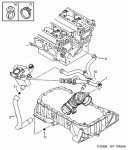I was driving around a few nights ago, and accelerated hard in 1st (foot to the floor from about 30km/h to 60km/h). A few seconds after this I noticed the engine had died, and wouldn't re-start. I found that the main engine management fuse in the engine bay fuse box had blown.
I walked to a nearby service station and bought some fuses, but the fuse blows as soon as the key is turned to ON. Which meant I had to walk 2km home and go rent a trailer with my spare ute, ughh!
This fuse, (number 15) is a 30 amp fuse, with the description:
"Throttle housing heater – Diesel injection pump – Oxygen sensor – Engine control unit – Air flow sensor – Ignition coil – Engine management solenoid valve – Diesel heater – Injectors - Variable engine timing solenoid valve - Variable engine air intake solenoid valve"
So far I have disconnected the 02 sensors, VVT solenoid, Injectors, Coil rail, Throttle body, Fuel pump (all still blew the fuse)
I disconnected the ECU and it didnt blow, but I'm not sure if that means anything as the ECU just tells most of these other components to do their thing I'd assume, so its just like a link in the chain.
The ECU still communicates with my scan tool, and I have a bunch of codes (obviously):
P1292 - Dual inlet. Activation of second air intake duct. Circuit, lower malfunction
P0261 - Injector 1 circuit low
P0264 - Injector 2 circuit low
P0267 - Injector 3 circuit low
P0270 - Injector 4 circuit low
P0076 - Intake valve control solenoid circuit low
P0351 - Ignition coil A primary/secondary circuit
P0352 - Ignition coil B primary/secondary circuit
P0353 - Ignition coil C primary/secondary circuit
P0354 - Ignition coil D primary/secondary circuit
P0135 - 02 sensor heater circuit sensor 1
P0141 - 02 sensor heater circuit sensor 2
P0012 - Camshaft position timing over retarded
But this makes perfect sense for that fuse simply being broken, except possibly for P0012... but I suspect it's related to the fuse.
This fuse is responsible for SO MANY THINGS! Does anybody know where the relays are located? Are they integrated into the fuse box, as a sealed unit? I can't seem to find the information I'm looking for in that regard.
I want to now check relays but that is where I'm stumped, as I have no idea where they are yet. And if it is simply a shorting wire somewhere, how the hell do I find that when it could be one of 10 different circuits?
Anyway I'm just putting this out there in the hopes there is something common that I'm missing, or to at least enrich the internet with my Pug woes.
I walked to a nearby service station and bought some fuses, but the fuse blows as soon as the key is turned to ON. Which meant I had to walk 2km home and go rent a trailer with my spare ute, ughh!
This fuse, (number 15) is a 30 amp fuse, with the description:
"Throttle housing heater – Diesel injection pump – Oxygen sensor – Engine control unit – Air flow sensor – Ignition coil – Engine management solenoid valve – Diesel heater – Injectors - Variable engine timing solenoid valve - Variable engine air intake solenoid valve"
So far I have disconnected the 02 sensors, VVT solenoid, Injectors, Coil rail, Throttle body, Fuel pump (all still blew the fuse)
I disconnected the ECU and it didnt blow, but I'm not sure if that means anything as the ECU just tells most of these other components to do their thing I'd assume, so its just like a link in the chain.
The ECU still communicates with my scan tool, and I have a bunch of codes (obviously):
P1292 - Dual inlet. Activation of second air intake duct. Circuit, lower malfunction
P0261 - Injector 1 circuit low
P0264 - Injector 2 circuit low
P0267 - Injector 3 circuit low
P0270 - Injector 4 circuit low
P0076 - Intake valve control solenoid circuit low
P0351 - Ignition coil A primary/secondary circuit
P0352 - Ignition coil B primary/secondary circuit
P0353 - Ignition coil C primary/secondary circuit
P0354 - Ignition coil D primary/secondary circuit
P0135 - 02 sensor heater circuit sensor 1
P0141 - 02 sensor heater circuit sensor 2
P0012 - Camshaft position timing over retarded
But this makes perfect sense for that fuse simply being broken, except possibly for P0012... but I suspect it's related to the fuse.
This fuse is responsible for SO MANY THINGS! Does anybody know where the relays are located? Are they integrated into the fuse box, as a sealed unit? I can't seem to find the information I'm looking for in that regard.
I want to now check relays but that is where I'm stumped, as I have no idea where they are yet. And if it is simply a shorting wire somewhere, how the hell do I find that when it could be one of 10 different circuits?
Anyway I'm just putting this out there in the hopes there is something common that I'm missing, or to at least enrich the internet with my Pug woes.








